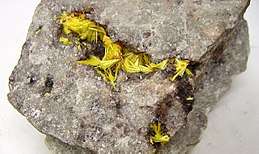Uranophane
Uranophane (Ca(UO2)2(SiO3OH)2·5H2O), also known as uranotile, is a rare calcium uranium silicate hydrate mineral that forms from the oxidation of other uranium-bearing minerals. It has a yellow color and is radioactive.
| Uranophane | |
|---|---|
 | |
| General | |
| Category | Uranyl neso- and polysilicates |
| Formula (repeating unit) | Ca(UO2)2[HSiO4]2·5H2O |
| Strunz classification | 9.AK.15 |
| Crystal system | Monoclinic |
| Crystal class | Sphenoidal (2) (same H-M symbol) |
| Space group | P21 |
| Unit cell | a = 15.85 Å, b = 6.98 Å c = 6.64 Å; β = 97.45°; Z = 2 |
| Identification | |
| Formula mass | 586.36 g/mol |
| Color | Light yellow, lemon-yellow, honey-yellow, straw-yellow, green-yellow |
| Crystal habit | Crystals occur as stellate needle aggregates; as fibrous crusts, and massive |
| Cleavage | {100} Perfect |
| Fracture | Uneven |
| Tenacity | Brittle |
| Mohs scale hardness | 2.5 |
| Luster | Vitreous to pearly; waxy or dull when massive |
| Streak | Yellowish white |
| Diaphaneity | Translucent to subtranslucent |
| Specific gravity | 3.81 - 3.90 |
| Optical properties | Biaxial (-) |
| Refractive index | nα = 1.643 nβ = 1.666 nγ = 1.669 |
| Birefringence | δ = 0.026 |
| Pleochroism | Weak; X = colorless; Y = pale canary-yellow; Z = canary-yellow |
| 2V angle | 32° to 45°, measured |
| Ultraviolet fluorescence | Weak yellow-green under both short and long UV |
| Other characteristics | |
| References | [1][2][3] |
References
| Wikimedia Commons has media related to Uranophane. |
This article is issued from Wikipedia. The text is licensed under Creative Commons - Attribution - Sharealike. Additional terms may apply for the media files.